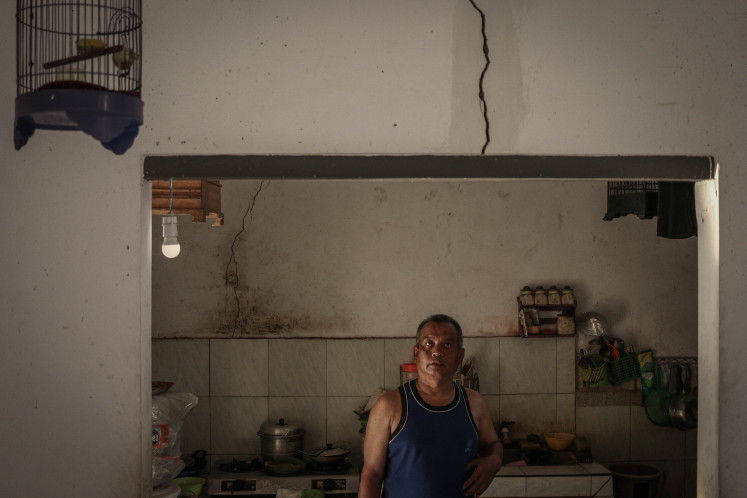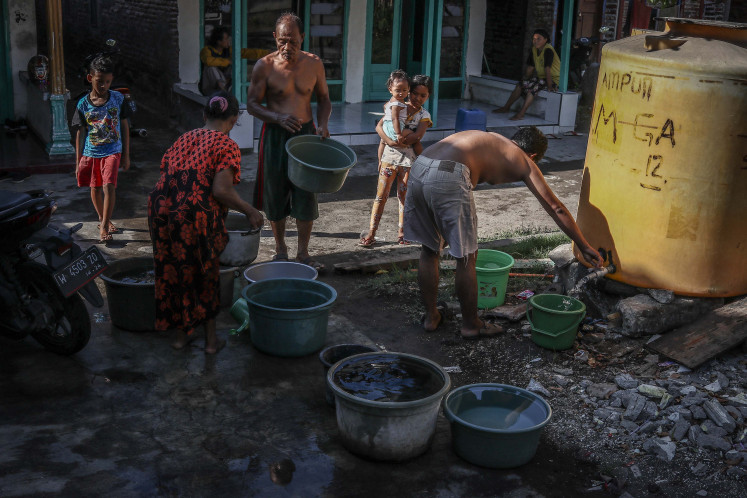Popular Reads
Top Results
Can't find what you're looking for?
View all search resultsPopular Reads
Top Results
Can't find what you're looking for?
View all search resultsNo end in sight: Sidoarjo mudflow continues to drown hopes, 15 years on
Mud has continued to flow over the past 15 years in Gempol Sari village, sinking hopes and homes along with it, in the unresolved aftermath of the mud volcano that erupted in Sidoarjo, East Java.
Change text size
Gift Premium Articles
to Anyone
H
ot wind and the sharp odor of methane is what Sukardi has experienced every day for the past 15 years in Polo Gunting hamlet of Gempol Sari village in Tanggulangin district, Sidoarjo regency, East Java.
Life has been full of hardship for the 52-year-old resident since a mud volcano erupted in 2006 in the adjacent district of Porong, about 5 kilometers from his house. The resulting mudflow slowly submerged the villages, rice fields and other places of his childhood, now immortalized only in Sukardi's memories. The mud also drowned his hopes for a better life and sank him deep into pessimism.
“I'm tired already. Even worse, I don't know in whom we should place our hopes. The government? I don't think depending on them is a good idea,” he told The Jakarta Post on May 29, the anniversary of the disaster.
“[Community] solidarity is the only thing that has kept me here until today. It helps me to accept all the conditions I've been through. Even if we feel broken and defeated, as long as we're together, we'll be alright," he said.
Sukardi's house is located just 50 meters or so from the embankment that was built to hold back the mudflow. His daily view is just mounds of earth, the gritty soil scattering into his yard whenever the wind blows hard. He has also been condemned to live an old age with the respiratory problems he developed after inhaling the polluted air every day.
“This village used to be beautiful. Every morning over there,” he said, pointing to the south, “Mount Arjuna-Welirang used to be such a sight.”
“Now look at the embankment and the wall. There is nothing beautiful about it,” Sukardi said, laughing.
Sukardi's house is slowly subsiding because of the embankment and as a result, he is constantly repairing and renovating his house. Sometimes, small mounds of earth appear suddenly, and he says not a day passes without the anxiety that his house will collapse due to the land shifting.
"Especially when it rains. Wow, I feel like I'm going have a heart attack all the time. The embankment cracked several times, [and] a heavy flow of mud seeped through. As a result, our house was flooded. It was pretty deep, up to the waist,” Sukardi said, covering his face with his hand. He then looked out beyond the vast embankment, which currently resembles a lake of mud.
'Chicken Little': Sukardi stands below a cracked wall in his house in Gempol Sari village in Sidoarjo, East Java, on May 29, 2021, the 15th anniversary of the Sidoarjo mudflow disaster. He is under constant strain from worrying that his house will collapse at any moment, as the land it stands on is sinking as a result of the disaster. (JP/Adryan Yoga)Sukardi said he had received a one-time payment of around Rp 1.5 million (US$105) as compensation in the 15 years that had passed since the disaster. Otherwise, he had been left to fend for himself in maintaining his house as well as his health.
“What's more, in the past, my livelihood was also affected. I was a farmer and owned a rice field. [...] I was prosperous. My field is not exactly sinking, but it's no longer clean and cannot be planted because it is often exposed to waste seeping from the embankment. Water mixed with mud has spread over the field several times. Now, I’ve ended up becoming a hawker like this. The income is miniscule, but what else can I do?" he said.
Contaminated water
The shortage of clean water is a critical issue for people who live near the Lapindo embankment. The 2006 disaster contaminated the water that supplies the villages in southern Sidoarjo with toxic substances. The water is a cloudy reddish-brown and tastes salty, and the residents must bear the costs of accessing a clean water supply.
One resident who has experienced this is Warsita, or “Grandmother Sita”, an elderly woman who lives with her grandson in Gempol Sari.
Sita said she had to pay Rp 10,000 every day for clean water, because the water that supplies her house can’t be used for anything other than washing the dishes. It cannot be used for washing clothes, which come out dirtier.
It is even worse for her family’s daily drinking needs, and there is no doubt that their health is at stake.
Bare minimum: Warsita sits with her grandson on May 29, 2021 in their home in Gempol Sari village, which was flooded with mud in the early days of the 2006 mudflow disaster in Sidoarjo, East Java. (JP/Adryan Yoga)"Rather than catching disease, we have to buy our own water supply whether we want it or not,” said Sita.
“The [house’s] water is so sticky, it's not fresh at all. If you mix the water with soap, no foam appears. We don't know about toxic substances or what [the water] contains. But just looking at it, something just doesn't seem right, don't you think?” she said.
Helping on threat of death
On the 15th anniversary of the Sidoarjo mudflow disaster, more commonly referred to as the “Lapindo mudflow disaster” in Indonesian media, nonprofit Komunitas Kecil Bergerak Indonesia (KKBI) delivered five 700-liter tanks to hold the village’s clean water supply.
The tanks have been placed around the village perimeter and are filled to the top every weekend. The villagers are not charged a single rupiah for either the water or the service, which are entirely funded by the KKBI.
The initiative has not been appreciated in some quarters, however, and Ardi Kurniaji of the four-member KKBI says he receives frequent calls threatening his life if he did not immediately stop helping the villagers. But he has no intention to do so, and rather intends to share the joys and sorrows of his fellow human beings, he says, as is his calling.
"I'm not afraid at all. Such threats are common, and also an understandable risk for me. After all, we don't ask for money from [the government], it's all from our own pockets. If my life ends here, I'm not afraid,” said Ardi.
The residents of Gempol Sari have been promised one year of clean water via the KKBI, which is self-funded. The community’s four young members, all creative workers, have set aside a portion of their income to help meet the needs of the people who live along the embankment.
Bitter irony
A thin man sits idly on a motorcycle, slowly smoking a cigarette. This is Puji Waluyo, better known locally as Mr. Keple (using the English term), who has been busy for the past decade guiding visitors on a tour to his submerged village. Occasionally, he offers them a DVD containing early amateur footage of how the mudflow occurred.
"This is ironic, actually. It is as if I am inviting strangers to visit our family's grave. The problem is, it's not just the land. There are history and memories that have been buried deep down beneath the mud,” he said with a small smile and turned away.
"But it is even more ironic if my family at home can't eat at all," Keple said, his eyes holding back tears.
Keple’s village, Jati Rejo, was submerged at the beginning of the long tragedy spawned by the disaster. He had to move from one rented house to another, he said, because he only received 20 percent of the compensation. While he declined to say how much, he said it led to a fight with one of his brothers who was also struggling with financial difficulties.
Water for life: The people of Gempol Sari village line up to fill containers with clean water on May 29, 2021 in Sidoarjo, East Java. A local nonprofit run by four youths, Komunitas Kecil Bergerak Indonesia (KKBI), provided five tanks that it fills every week with clean water, but one member says he has received death threats for helping the village. (JP/Adryan Yoga)Since COVID-19 broke out in Indonesia, Keple said he could count the tourists who visited the embankment on one hand. In the 2010s, he could bring home hundreds of thousands of rupiah each day, but over the past year, he sometimes didn’t make enough to cover the gasoline for his motorcycle. He endured hunger all day long just so he could bring home a meager income for his family.
"Now, earning just Rp 50,000 is a struggle. Even on weekends, I don't make that much. Just today, an important day, I only had one customer,” he said, referring to the anniversary of the disaster. “But this is not so bad, [it’s] better than nothing."
Keple took the Post to tour the 7.5-square-kilometer area the embankment contains and stopped at a place where dredgers were anchored. He threw away the cigarette he was smoking and with a trembling finger, pointed to the expanse of mud, saying in a hoarse voice that this was where his house once stood.
"Now you can imagine it, right? Just imagine how deep was the mud that inundated our village. Fifteen years and nothing is settled. Even by them, the culprit of all this tragedy. Masya Allah ['dear God'],” he said, wiping at the slow tears falling from his eyes.
Keple was referring to oil and gas company PT Lapindo Brantas that was drilling for gas in the area at the time of the disaster, which has been widely determined to be a manmade disaster and not a natural one.
The mud has continued to flow over the years, inexorably sinking the people’s hopes for a solution or settlement, let alone any improvements to their lives or living conditions. Sukardi, Keple and Granny Sita seem to believe that eventually, their village will become a giant mud lake.
"If [the mudflow] is not resolved, it will be as though the other villages are just waiting for their turn. Yesterday, you could see that my village was drowning. But tomorrow, it could be your village, nobody knows,” Keple said.














